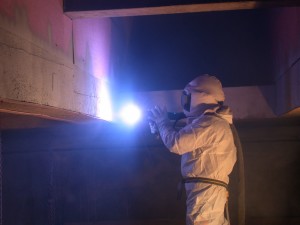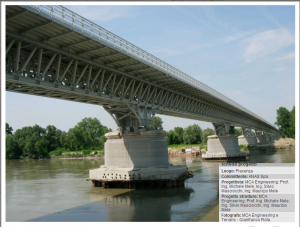The collapse of the bridge Morandi, occurred in August 2018, It marks the final sunset of the myth that the reinforced concrete or prestressed has an unlimited life.
According to the OECS, many are the causes of the progressive degradation but all, At bottom, depend on the corrosion (rust): electrochemical phenomenon that triggers when the chlorides of de-icing salts penetrate the concrete, or with carbonation when the CO2 lowers the value of the environment under ph 9-10. rust, silent worm of iron structures, Due to the increase in volume of the rod from 2 a 6 fold compared to the original volume, creating the yield strength of the cement with the collapse or spalling (cracking).
Without the necessary and appropriate maintenances, iron crumbles and cement "armed" becomes "disarmed".
In practice, using different liquid coatings, Unfortunately, they only semi-impermeable barrier to air and moisture, others act as inhibitors; both of them, But, not as effective as zinc (the real "skin" of the steel and not just covering). This, indeed, armature ensures a dual protection: active electrochemical (anodic, sacrificial or galvanic) and passive (effetto barriera), isolating it from attack by external environmental factors. No other system combines these two properties.
And 'thanks to this technological supremacy that Professor Herbert Hermann, the Department of Materials Science and Engineering, University of New York, It defines the spray galvanizing the most effective system against corrosion and attributes its scarce diffusion to the ignorance of the prescribers, laziness traffic authorities, the lobby of the paint manufacturers and, finally, the deplorable scourge of procurement downward. Studies conducted in the US showed that the average life of the surface treated with hard spray galvanizing least 20 years; this period may be further extended with an organic coating or epoxy deposited on the layer of zinc which is thus isolated from the atmosphere, for which the oxidation occurs within zinc-cement interface at a reduced rate of corrosion (the Zn consumption is equal to 50% of normal exposure).
The spray galvanizing process is simpler, quickly and inexpensively compared to conventional systems. In addition to structural advantages, It is easy execution of the surface and the preparation consists of:
– elimination of damaged parts from chlorides (at least 1 cm under armor) until you reach the healthy concrete;
– SA3 blasting degree of roughness;
– spray coating of Zn or Zn / Al 85/15 (thickness up to 500 mm) of dry iron within 15 minutes of blast, placing the gun 10-15 cm; relative humidity less than 60%;
– recoating with cement within 24 hours and further spraying of zinc to cover the pores of the cement.
The effect will be that the corrosion attack of preference Zinc (less noble metal) which it acts as a sacrificial anode in place of the iron (cathode).
And 'demonstrated that, in chlorinated environments, The galvanized round has an average life of 3-4 times higher than the bare iron, the adherence of the Zn varies from 1,5 a 3,5 Mpa (request 0,75 Mpa).
The first spray galvanizing applications date back to 1983 In the USA. This technique can be applied in three ways:
1.as Cathodic Protection (CP) without reprofiling: Zinc is sprayed directly on the iron and exposed on the surface of the concrete, while leaving unaltered lesions. It 'a viable alternative to the impressed current.
The other two systems provide reprofiling:
2. as Cathodic Protection (CP) with reprofiling: the zinc coating is sprayed onto the concrete after repairing the cracks. In this case, you can measure the passage of current between the electrodes, this can be adjusted by means of resistors. In case of a too low conductivity Concrete, it has a lower rod of the protection. For this reason, systems like this will only work in atmospheres containing sufficient moisture and high temperature.
3. Currents as imprinted (ICCP): before the deposition of zinc, It runs the reprofiling of concrete which acts as electrolyte. The cathodic protection is not derived from the difference of potential between the zinc anode and the rod, but by an external electric current. The chlorides and hydroxides migrate from the cathode (concrete) all'anodo (zinc).
The three solutions are possible in humid environments. Need, anyway, evaluate in advance for every situation the need for an external energy source. The optimum conditions for the solutions that do not provide current imprinted you have in areas not subject to drought, such as coastal areas and tropical ones.
The rehabilitation of damaged structures is costly repairs that increase progressively according to De Sitter "Law of 5": 1 Euros spent during construction equals 5 Euros for maintenance costs for the replacement, a 25 Euros in the phase where corrosion is triggered locally and the concrete cover presents cracks and detachments (need to replace the deteriorated concrete), until 125 Euros when injuries and spalling are present on a large scale.
Some pictures of the effects of corrosion of the iron rod
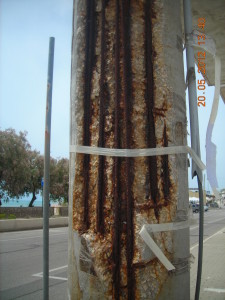
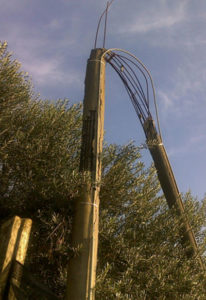
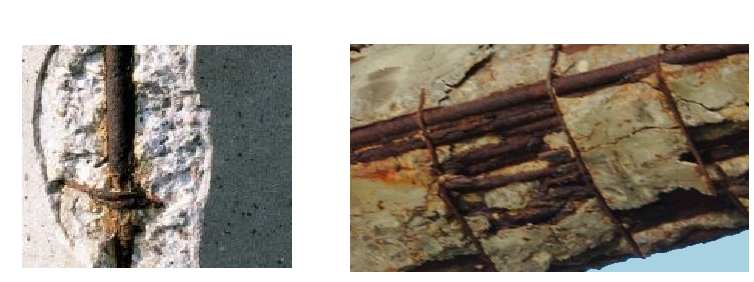
decisive interventions
